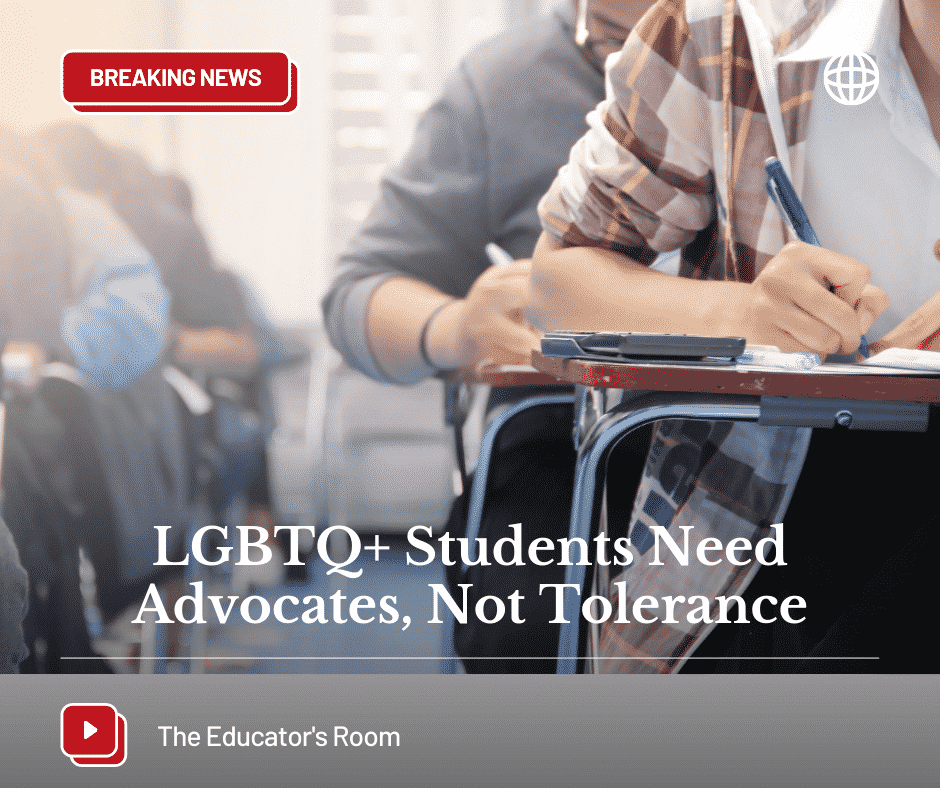As pride month comes to a close, we should consider the needs of our students who are members of the LGBTQ+ community. To be sure, these students have needs that go unmet daily. Considering how homogeneous and patriarchal most curricula are, we have a long way to go to equitably represent the LGBTQ+ community.
Rather than flexing our “tolerance muscles,” we might want to consider how to transition from tolerating underrepresented communities to affirming and accepting them. One struggle that most educators face during the first week of school is remembering students’ names. Now, teachers are also challenged with remembering students’ preferred names as well as their preferred pronouns. This is no easy feat, especially when our mind constantly tells us that “Monica is a girl,” or that “John is a boy.”
Even if we mistakenly use the wrong pronoun, we should ensure that students’ identities are accepted, rather than tolerated. Despite our biases, political affiliation, or natural inclinations, students deserve to learn in an environment where they feel seen and accepted.
You may find though, that some may be a bit resistant to accept students’ new identity. I witnessed teachers purposefully avoid using students’ preferred pronouns due to personal biases against all things LGBTQ+. Students, too, may struggle to use their peers’ proper pronouns and preferred names.
On one such occasion, a tense conversation took place in a Google Meet during class. During a friendly game of connect four during a brain break, one student referred to another student by her birth name, which is not how [they] identify. The student offended gently mentioned that she identifies as Dev, [they/them].
I was proud of Dev for being assertive and setting boundaries that were reasonable and politely stated. However, the student responded, “she is a girl, so I’m calling her she/her!” The chat erupted, some students supported Dev by explaining Dev’s pronouns while others exasperated the issue at hand by seizing this opportunity to make a joke.
After thanking the students for supporting Dev, I explained to the class the importance of pronouns and identity. I emphasized that even in the virtual setting, we are a family, period. Family should not debate about another family member’s identity but should use language that makes everyone feel accepted and heard.
After a couple of minutes, the student apologized and now refers to Dev as Dev, using their preferred pronouns as well. Though this issue could have been avoided with a little compassion and empathy, I’m glad the class experienced the debate. After settling the debate, I noticed that the two students became virtual friends, building on each others’ responses throughout the school year.
To be frank, it doesn’t matter how many LGBTQ+ members you show in a presentation, cut out and tape to the classroom wall or display on Youtube if you struggle to accept the actual LGBTQ+ students in your classroom. Our students are not asking us to understand them or to agree with them, but they are entitled to respect.
Being an LGBTQ+ ally means more than supporting students when it is easy or convenient to do so. On the contrary, being an ally requires us to support this population of students regardless of how we feel about their personal decisions. Our biases should have no bearing on whether or not we respect students.
Remember, tolerating members of the LGBTQ+ community is more like separate but equal legislation that suggests that certain people are worthy enough to be in the same space as us, but not worthy enough to be recipients of humanity and kindness. You have the power to be a catalyst for change, by demonstrating that all students deserve love and respect.







Suggesting an edit to this portion: “During a friendly game of connect four during a brain break, one student referred to another student by her birth name, which is not how [they] identify. The student offended gently mentioned that she identifies as Dev, [they/them].”
During a friendly game of connect four during a brain break, one student referred to another student by their birth name, which is not how they identify. The student offended gently mentioned that they identify as Dev and use the pronouns “they/them.”
The reason I suggest these changes is that when you used the pronouns she and her in your own writing, you did make the unintentional error of perpetuating an incorrect description of this child, who is not a she nor a her. This student was not she or her when the other student referred to them that way, so there is no need for you to ever describe the student using incorrect pronouns even if you are speaking about them in the past.
This is a standard take within journalism and although I am not a journalist, I hope I was able to express it in a way you find helpful.
Thank you for your support of your students and all that I learned from your writing, which I did share with my network. You are clearly able to show caring regardless of whether you always remember to use the correct language, whereas some teachers never get their grammar mixed up but are faking it. So you are tremendously appreciated.